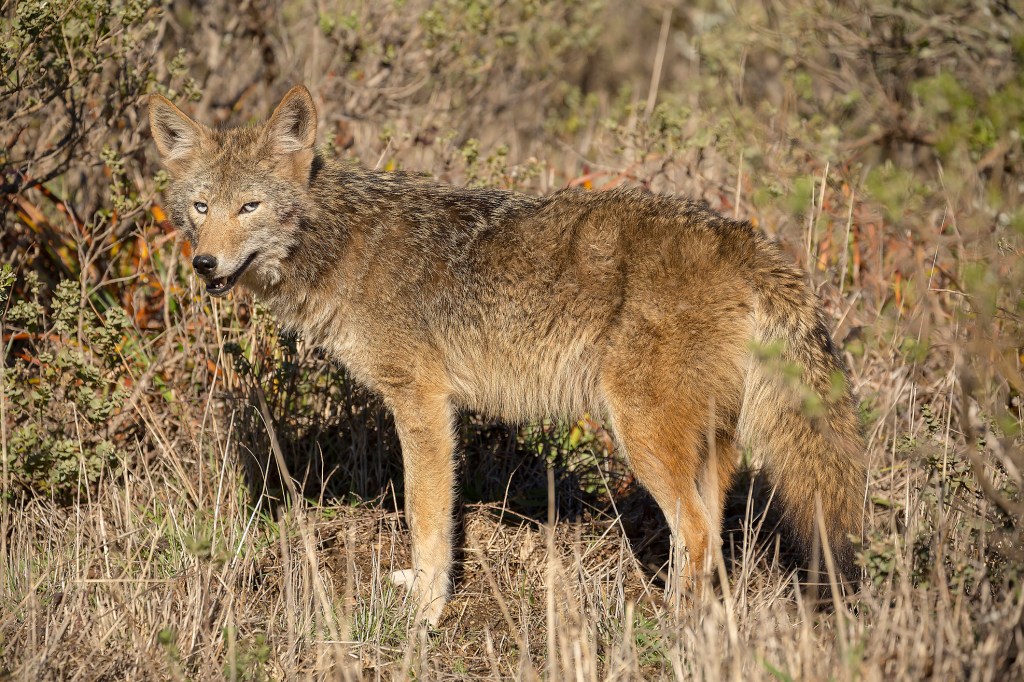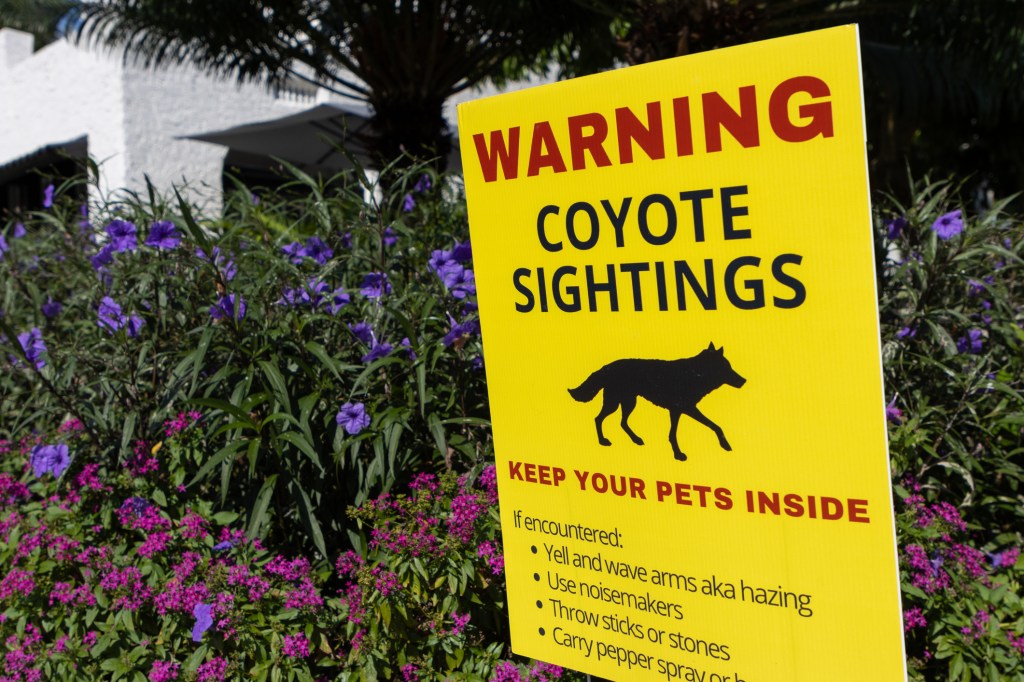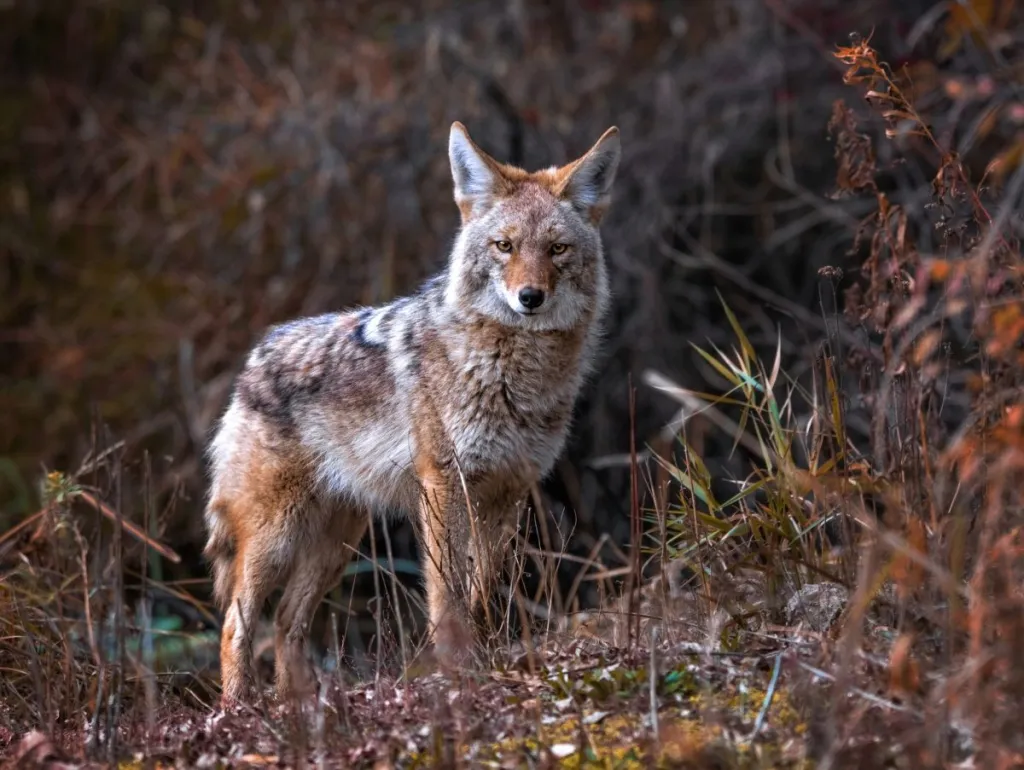As humans spread into coyote habitats with their pets more and more, the odds of encounters between dogs and coyotes skyrocket. These encounters can be deadly, especially for small dogs who make for easy prey. Humans are good sources of garbage and food, which can attract coyotes, too.
Late January through early March is mating season for coyotes, and from April to August, coyotes begin to have their puppies. During this time, they hunt more actively to provide for their young. As such, they also become more defensive of their territory.
Attacks may be more likely during that time, but in winter when resources are scarce, coyotes can also grow desperate for food. They sometimes move into human domains, which can cause more incidents with dogs.
It’s important to stay vigilant all year long and protect your dog from a coyote attack or any encounter with a harmful wild animal. Here are eight ways you can reduce the risk of coyote attacks on your dog and protect your pup if you happen to see a coyote.
The best ways to protect your dog from a coyote attack

Being situationally aware is a key trait of proactive pet parents. Be on the lookout for signs coyotes are entering your yard or neighborhood. Note if your dog is acting differently at night or is bothered by certain smells on your property. Your pup could be reacting to the scent of a coyote. Also look for coyote tracks, rope-like scat, discarded prey, or indications your trash and recycling have been rummaged through.
Fence your yard
A fence does not provide complete protection from coyote attacks, as these animals can dig or climb if they need to, but it can reduce the risk of a coyote encounter. If you have a yard, make sure it has a durable fence that can reasonably block the view of your dog from the outside.
A solid, high fence can provide a necessary barrier and prevent many — though not all — attacks. However, installing a fence that is coyote-proof can be prohibitively expensive for many. If you are unable to build an 8-foot-tall fence, a shorter fence with coyote rollers may do the trick. These aluminum tubes spin and reduce the coyote’s traction when they touch them, thereby humanely deterring the animal from entering your property. You’ll also need to install either a ground apron or a buried predator apron — which is essentially wire fencing — to a depth of 18 inches underground.
An invisible fence is not a good choice for many reasons, and one of these reasons is that it allows coyotes to enter your property while your dog has no way of escaping. Moreover, chain link fences will allow coyotes to see your dog and further provoke them into attacking.
Always keep an eye on your dog when they’re outside
Even with a fence, it’s important that you supervise your dog’s activity while they’re out in your yard, especially at night when coyotes are more likely to be active. As mentioned earlier, a desperate coyote will climb or dig if they need to.
Keeping an eye on your dog when they’re outside will let you be ready to help them at the first sign of any danger. What’s more, a coyote will likely be more afraid of you than they are of your dog. That’s especially true if you engage in behaviors that make you appear more threatening to coyotes from afar. In particular, this includes looking larger and making loud, authoritative noises while waving your arms.
Get an outdoor light
Coyotes tend to steer clear of bright lights. Get a motion detector light for your yard, or have a light that you can turn on while your dog is out. Coyotes are opportunistic, nocturnal predators, so the key is preventing them from having an easy opportunity to attack your pet.
Having a flashlight handy will also be helpful, as you can use it to scare off any coyotes that approach. This is especially necessary for nighttime walks. Don’t leave home without one. Even a small keychain light is better than nothing. Most cell phones also have bright flashlights, but be sure your device is charged up before leaving home.
Don’t leave out food or garbage
Your dog may prefer to eat outside, but it’s not a good idea to leave out food or empty bowls that smell like food. Additionally, all garbage bins should be properly sealed so as not to attract wildlife. If you do not store your barbecue grill in a shed or enclosed area, be sure to properly burn off any remaining food particles and scents after you use it. Coyotes will scavenge when they’re hungry, and human garbage cans are excellent sources of food.
You may enjoy having birds on your property and leave a bird feeder out, but just be aware that coyotes do hunt birds, and this may increase your risk of a coyote encounter.
If you have raised beds or a vegetable garden, be sure the area around it is securely fenced. Additionally, if you have fruit trees or bushes in your yard, don’t delay gathering and composting or discarding fallen fruit.
Avoid places where coyotes can hide
Coyotes tend to hide in underbrush and bushes, so if you have these on your property, make sure they’re maintained and don’t provide coyotes with a place to lie in wait. Seal areas under your porch, deck, or sheds where coyotes may hide. Be sure to utilize underground wire to prevent them from digging under any fencing or woodwork.
If you’re out walking your dog, stick to cleared trails and paths, and don’t wander. Be mindful of open storm drains and unscreened culverts where coyotes could be lurking in your neighborhood. Even if you don’t encounter a hungry coyote, you may accidentally enter their territory and be perceived as a threat.
Always keep your dog on leash during walks
No matter how well-behaved your dog is, you have to be able to keep them under control if there’s an emergency. Irrefutably, a coyote encounter can quickly become an emergency.
You can’t know how your dog will react to a confrontation, and you need to have a way to restrain them and pull them to safety. Always leash your dog on walks. However, don’t rely on a retractable leash, as these can easily break and won’t allow you to maintain the control you need to reel in your dog quickly. Use a sturdy leash that’s short enough to keep your dog reasonably close to you. Ideally, choose a leash that is less than six feet in length. Even better, consider using a supportive harness for longer walks or potty breaks where your dog could encounter a wild animal.
Be calm, be big, be loud
If you do encounter a coyote, try everything you can to intimidate them. Stay calm, make yourself as big as possible, and yell. Coyotes usually will not attack if you’re perceived as being a serious threat.
Back away slowly and pick up your dog if you’re able to. Use your flashlight if you can to scare the coyote away.
You’ll want to leave their territory as soon as possible, especially if their young are nearby. Most importantly, do not run, as this can provoke the coyote to attack.
Report sightings in your area
Reporting coyote sightings can help you and your neighbors stay alert and cautious. In addition, it will provide animal control with information that can help them capture and relocate coyotes that may be a danger to humans and pets. Be responsible and encourage others in your community to do so, as well.
Other ways to protect your dog from coyotes

In addition to the easy ways listed to ensure your pet’s safety, there are a few other tips and lifestyle changes to employ to protect your dog from a coyote. Some of these are a bit more involved or cost more money to implement. However, if you have the time and treasure to do so, you could save yourself any future heartache and potentially prevent some expensive emergency vet bills. Outside of bringing home a donkey, llama, or livestock guardian dog, these options — used in concert with the eight tips above — could help stave off threats to your pup.
Install sprinklers
Coyotes are not a big fan of water. As such, having a sprinkler system or even a garden hose handy can help you protect your dog in the event of a coyote encounter. Squirting the animal with a spray bottle is also an option, although the sprinkler and hose have the added benefit of increasing your range and keeping you at a safer distance from the predator.
Consider purchasing a coyote vest
The verdict is still out on whether or not a coyote vest is a beneficial purchase. Some dog owners swear by them, believing the puncture-proof fabric could minimize any injury inflicted in a coyote attack. Proponents claim the biggest benefit of the garment is its ability to serve as a potential deterrent.
At the same time, some pups feel emboldened by their larger appearance and may engage in riskier behaviors while donning the apparel. Other opponents of coyote vests are concerned the design may make some dogs more attractive to predators while also decreasing a dog’s agility by restricting their movement. As such, there are worries that the pup may actually have a more difficult time escaping a hostile situation if one occurs.
Buy or make coyote hazing tools
Hazing is a more humane way to address coyote sightings than harming or killing the animal. After all, coyotes are likely only entering suburban or urban areas because their own habitats have been destroyed or encroached upon by development. While they can be a serious threat to dogs and cats, there are methods to scare coyotes away and protect your pet. At the same time, these mostly harmless tricks and deterrents help to reinforce the idea that these predators should fear humans. As coyotes become more habituated, the threat they pose will unfortunately increase.
Outside of yelling and making yourself appear larger, consider carrying noisemakers with you when walking your dog. You can purchase an air horn, whistle, or loud bell. Alternatively, you can make your own by putting pennies or marbles in a jar or old coffee can. If a coyote approaches, shake the device vigorously while also yelling at the animal. Pie pans, pot lids, or even symbols will often also do the trick, but those are a bit less practical if you’re leaving your own yard. Some people choose to carry pepper spray, bear repellent, or either a water gun or spray bottle full of a mixture of water and vinegar, as well.
Physical deterrents such as projectiles can also be used to scare off a coyote. If you decide to go this route, be mindful not to hit the coyote with the objects but just to throw them close enough to scare the animal away. You can use small sticks, tennis balls, or rocks to achieve this aim.
Alter your dog’s feeding and walk schedule
You can’t always help when your dog needs to do their business. However, if you live in an area prone to coyote encounters, consider slightly altering your feeding and potty schedule — especially as the time changes. Knowing it will get dark earlier in the winter months, adjust your pup’s expectations for when they will get dinner and exercise. Since coyotes tend to be more active at night, it’s best to keep evening walks short and in well-lit, busy areas if possible. To put it another way, take your dog on a longer walk before dusk and just stick to a quick potty break for any outdoor trips after dark. This will ensure both your dog’s and your safety.
And, at night, be sure to close any pet doors. You don’t want to wake up to any other wild animals having entered your home either.
Stay safe out there!









